2806 NRS: Critical Evaluation of a Nursing Research Study Report
VerifiedAdded on 2023/01/04
|12
|3109
|61
Report
AI Summary
This report provides a critical evaluation of a randomized control trial (RCT) investigating the use of skin glue to improve the success rate of peripheral intravenous catheters (PICs). The study, conducted in a hospital setting, aimed to determine if the addition of skin glue to standard PIC insertion procedures could reduce the rate of failure within 48 hours. The report analyzes the study's PICO elements, journal impact, and author credentials, and critically evaluates the title, abstract, and literature review. It examines the quantitative research design, sample, data collection methods, and data analysis techniques. The results section highlights the positive impact of skin glue in reducing PIC failure, dislodgement, and infections. The report discusses the study's relevance to nursing practice, emphasizing its implications for patient values, clinical expertise, and evidence-based practice. The conclusion stresses the potential for improved patient outcomes, reduced healthcare costs, and enhanced hospital care. The report also identifies that the research adds more knowledge to clinical practice.

Running head: Nursing 1
Nursing In Research
by
Course:
Tutor:
University:
Department:
Date:
Nursing In Research
by
Course:
Tutor:
University:
Department:
Date:
Paraphrase This Document
Need a fresh take? Get an instant paraphrase of this document with our AI Paraphraser
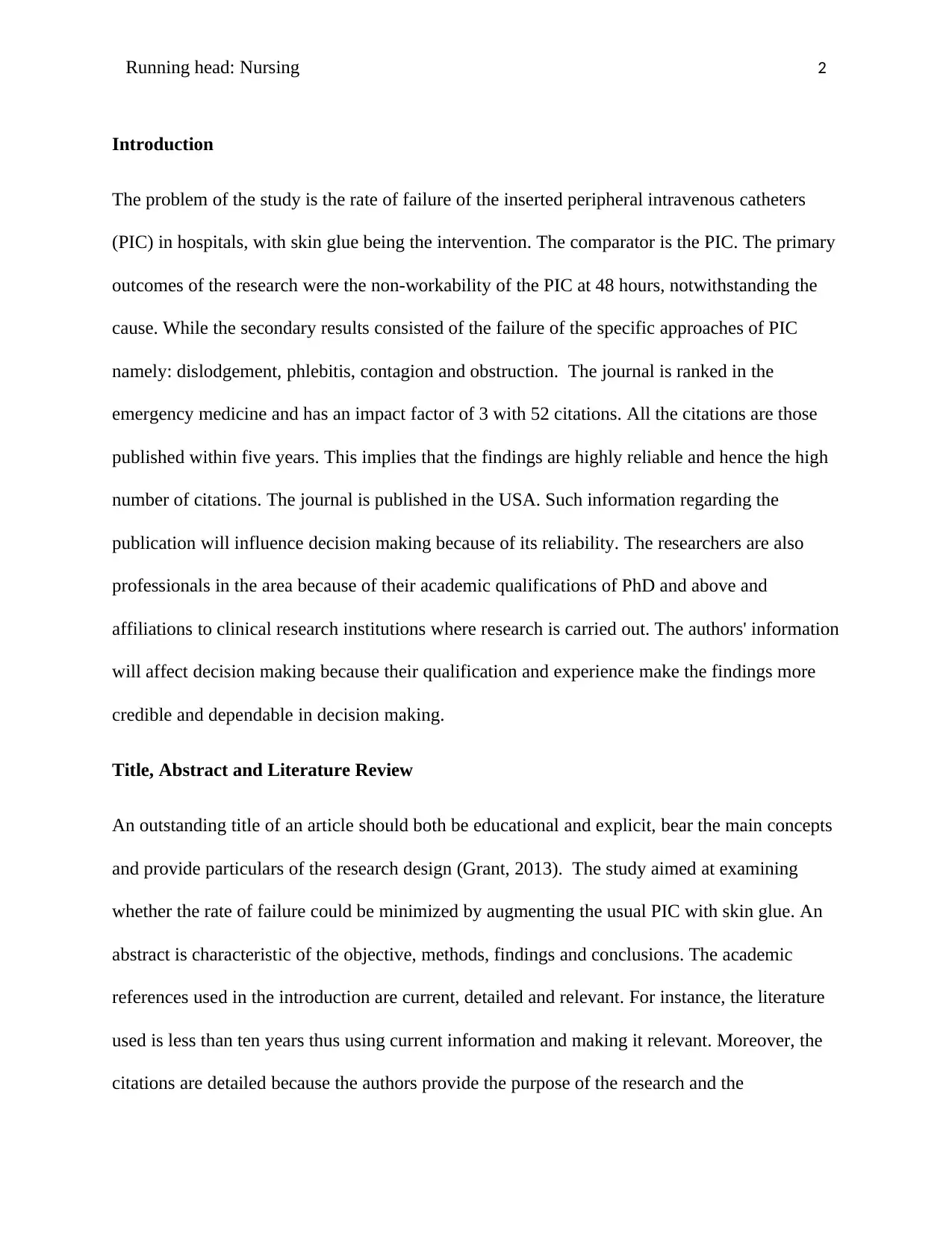
Running head: Nursing 2
Introduction
The problem of the study is the rate of failure of the inserted peripheral intravenous catheters
(PIC) in hospitals, with skin glue being the intervention. The comparator is the PIC. The primary
outcomes of the research were the non-workability of the PIC at 48 hours, notwithstanding the
cause. While the secondary results consisted of the failure of the specific approaches of PIC
namely: dislodgement, phlebitis, contagion and obstruction. The journal is ranked in the
emergency medicine and has an impact factor of 3 with 52 citations. All the citations are those
published within five years. This implies that the findings are highly reliable and hence the high
number of citations. The journal is published in the USA. Such information regarding the
publication will influence decision making because of its reliability. The researchers are also
professionals in the area because of their academic qualifications of PhD and above and
affiliations to clinical research institutions where research is carried out. The authors' information
will affect decision making because their qualification and experience make the findings more
credible and dependable in decision making.
Title, Abstract and Literature Review
An outstanding title of an article should both be educational and explicit, bear the main concepts
and provide particulars of the research design (Grant, 2013). The study aimed at examining
whether the rate of failure could be minimized by augmenting the usual PIC with skin glue. An
abstract is characteristic of the objective, methods, findings and conclusions. The academic
references used in the introduction are current, detailed and relevant. For instance, the literature
used is less than ten years thus using current information and making it relevant. Moreover, the
citations are detailed because the authors provide the purpose of the research and the
Introduction
The problem of the study is the rate of failure of the inserted peripheral intravenous catheters
(PIC) in hospitals, with skin glue being the intervention. The comparator is the PIC. The primary
outcomes of the research were the non-workability of the PIC at 48 hours, notwithstanding the
cause. While the secondary results consisted of the failure of the specific approaches of PIC
namely: dislodgement, phlebitis, contagion and obstruction. The journal is ranked in the
emergency medicine and has an impact factor of 3 with 52 citations. All the citations are those
published within five years. This implies that the findings are highly reliable and hence the high
number of citations. The journal is published in the USA. Such information regarding the
publication will influence decision making because of its reliability. The researchers are also
professionals in the area because of their academic qualifications of PhD and above and
affiliations to clinical research institutions where research is carried out. The authors' information
will affect decision making because their qualification and experience make the findings more
credible and dependable in decision making.
Title, Abstract and Literature Review
An outstanding title of an article should both be educational and explicit, bear the main concepts
and provide particulars of the research design (Grant, 2013). The study aimed at examining
whether the rate of failure could be minimized by augmenting the usual PIC with skin glue. An
abstract is characteristic of the objective, methods, findings and conclusions. The academic
references used in the introduction are current, detailed and relevant. For instance, the literature
used is less than ten years thus using current information and making it relevant. Moreover, the
citations are detailed because the authors provide the purpose of the research and the

Running head: Nursing 3
corresponding statistical findings (Bugden et al., 2016). The research title is consistent with the
text because the findings answer the aim of the research.
Research Design
The quantitative research is RCT with level II evidence (Clarke, Gillies, Illari, Russo, &
Williamson, 2014). The research question is “Does the inclusion of skin glue to the usual PIC
minimize its rate of failure?” the study was needful because of the prevalent rate of failure of
PIC (Marsh, Webster, Mihala, & Rickard, 2015), which is also used widely and more often in the
emergency department (ED) (Limm, Fang, Dendle, Stuart, & Warburton, 2013). Untimely
failure of devices happens in almost half of the equipment due to contagion, obstruction, or
dislodgement (Marsh et al., 2015), due to insufficient fixation of the PIC to the skin of the patient
leading to dislodgement, micromotion and other bacterial infections through the open skin
(Marsh et al., 2015). Other methods have been tried out to help secure peripheral catheters, for
instance, the use of cloth-bordered and borderless polyurethane dressings, and locally sold
securement devices.
Notwithstanding, the frantic efforts to try to use alternative methods, still there is uncertainty as
to the most appropriate method to prepare and protect PIC (Marsh et al., 2015). However, there
is little evidence of the efficacy of the use of recommended skin glue at the insertion site
(Reynolds et al., 2015; Edwards et al., 2014). Therefore, the current study seeks to test the
hypothesis whether the inclusion of skin glue to the site of insertion of PIC in the hospital would
minimize the rate of failure of the equipment within 48 hours. The above-stated hypothesis is a
scientific hypothesis. The study participants were divided into the standard care group which was
corresponding statistical findings (Bugden et al., 2016). The research title is consistent with the
text because the findings answer the aim of the research.
Research Design
The quantitative research is RCT with level II evidence (Clarke, Gillies, Illari, Russo, &
Williamson, 2014). The research question is “Does the inclusion of skin glue to the usual PIC
minimize its rate of failure?” the study was needful because of the prevalent rate of failure of
PIC (Marsh, Webster, Mihala, & Rickard, 2015), which is also used widely and more often in the
emergency department (ED) (Limm, Fang, Dendle, Stuart, & Warburton, 2013). Untimely
failure of devices happens in almost half of the equipment due to contagion, obstruction, or
dislodgement (Marsh et al., 2015), due to insufficient fixation of the PIC to the skin of the patient
leading to dislodgement, micromotion and other bacterial infections through the open skin
(Marsh et al., 2015). Other methods have been tried out to help secure peripheral catheters, for
instance, the use of cloth-bordered and borderless polyurethane dressings, and locally sold
securement devices.
Notwithstanding, the frantic efforts to try to use alternative methods, still there is uncertainty as
to the most appropriate method to prepare and protect PIC (Marsh et al., 2015). However, there
is little evidence of the efficacy of the use of recommended skin glue at the insertion site
(Reynolds et al., 2015; Edwards et al., 2014). Therefore, the current study seeks to test the
hypothesis whether the inclusion of skin glue to the site of insertion of PIC in the hospital would
minimize the rate of failure of the equipment within 48 hours. The above-stated hypothesis is a
scientific hypothesis. The study participants were divided into the standard care group which was
⊘ This is a preview!⊘
Do you want full access?
Subscribe today to unlock all pages.

Trusted by 1+ million students worldwide
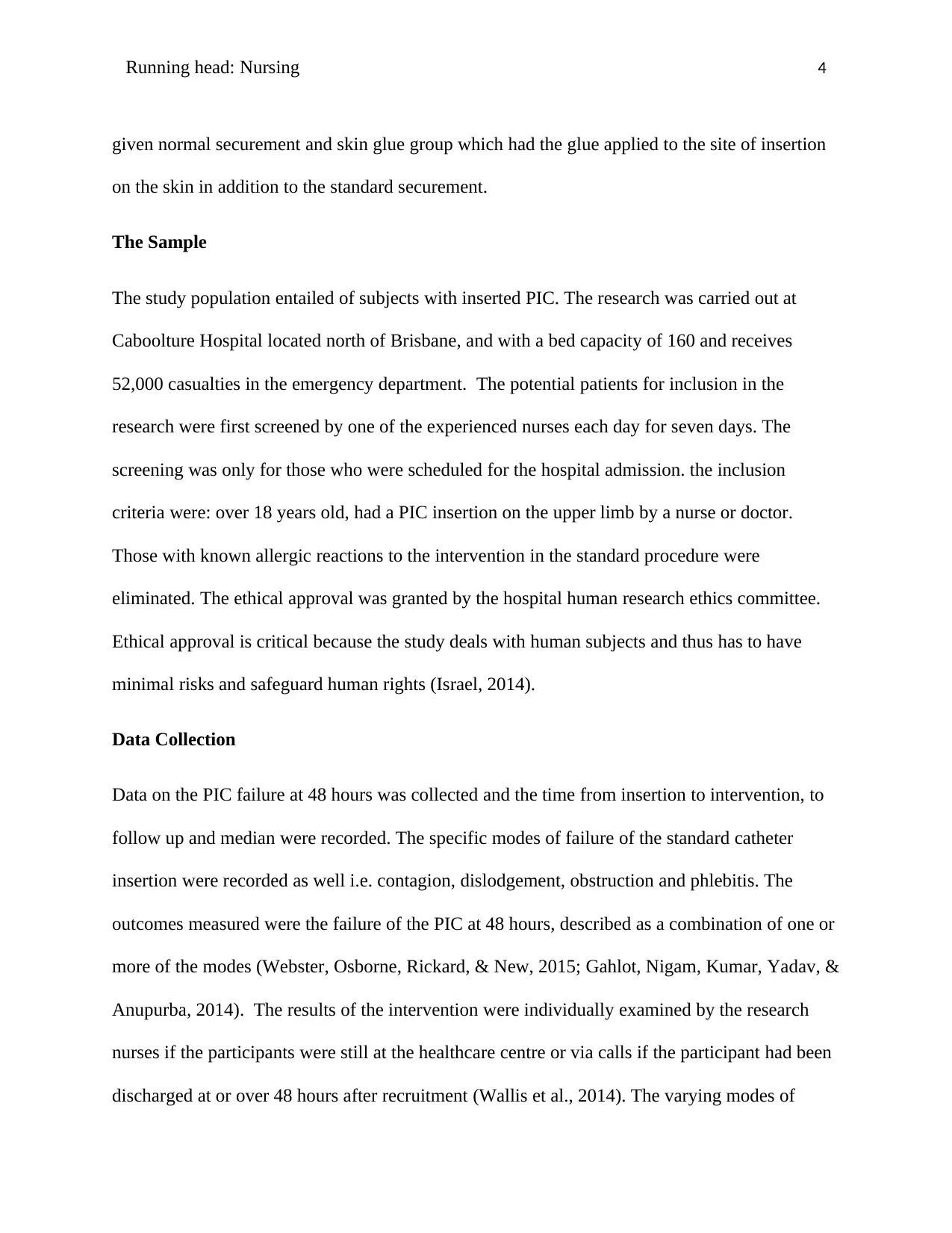
Running head: Nursing 4
given normal securement and skin glue group which had the glue applied to the site of insertion
on the skin in addition to the standard securement.
The Sample
The study population entailed of subjects with inserted PIC. The research was carried out at
Caboolture Hospital located north of Brisbane, and with a bed capacity of 160 and receives
52,000 casualties in the emergency department. The potential patients for inclusion in the
research were first screened by one of the experienced nurses each day for seven days. The
screening was only for those who were scheduled for the hospital admission. the inclusion
criteria were: over 18 years old, had a PIC insertion on the upper limb by a nurse or doctor.
Those with known allergic reactions to the intervention in the standard procedure were
eliminated. The ethical approval was granted by the hospital human research ethics committee.
Ethical approval is critical because the study deals with human subjects and thus has to have
minimal risks and safeguard human rights (Israel, 2014).
Data Collection
Data on the PIC failure at 48 hours was collected and the time from insertion to intervention, to
follow up and median were recorded. The specific modes of failure of the standard catheter
insertion were recorded as well i.e. contagion, dislodgement, obstruction and phlebitis. The
outcomes measured were the failure of the PIC at 48 hours, described as a combination of one or
more of the modes (Webster, Osborne, Rickard, & New, 2015; Gahlot, Nigam, Kumar, Yadav, &
Anupurba, 2014). The results of the intervention were individually examined by the research
nurses if the participants were still at the healthcare centre or via calls if the participant had been
discharged at or over 48 hours after recruitment (Wallis et al., 2014). The varying modes of
given normal securement and skin glue group which had the glue applied to the site of insertion
on the skin in addition to the standard securement.
The Sample
The study population entailed of subjects with inserted PIC. The research was carried out at
Caboolture Hospital located north of Brisbane, and with a bed capacity of 160 and receives
52,000 casualties in the emergency department. The potential patients for inclusion in the
research were first screened by one of the experienced nurses each day for seven days. The
screening was only for those who were scheduled for the hospital admission. the inclusion
criteria were: over 18 years old, had a PIC insertion on the upper limb by a nurse or doctor.
Those with known allergic reactions to the intervention in the standard procedure were
eliminated. The ethical approval was granted by the hospital human research ethics committee.
Ethical approval is critical because the study deals with human subjects and thus has to have
minimal risks and safeguard human rights (Israel, 2014).
Data Collection
Data on the PIC failure at 48 hours was collected and the time from insertion to intervention, to
follow up and median were recorded. The specific modes of failure of the standard catheter
insertion were recorded as well i.e. contagion, dislodgement, obstruction and phlebitis. The
outcomes measured were the failure of the PIC at 48 hours, described as a combination of one or
more of the modes (Webster, Osborne, Rickard, & New, 2015; Gahlot, Nigam, Kumar, Yadav, &
Anupurba, 2014). The results of the intervention were individually examined by the research
nurses if the participants were still at the healthcare centre or via calls if the participant had been
discharged at or over 48 hours after recruitment (Wallis et al., 2014). The varying modes of
Paraphrase This Document
Need a fresh take? Get an instant paraphrase of this document with our AI Paraphraser

Running head: Nursing 5
insertion consisted of secondary outcomes and were measured using charts, same patient
questionnaire and through direct visualization.
Data collection was done using the peripheral intravenous catheter devices as units of
measurements. These are quality tools because they have been standardized in other previous
studies, and thus their quality determined prior. Data collection was carried out by research
nurses if the participants were still at the healthcare centre or using calls if the participant
released at or over 48 hours after recruitment (Wallis et al., 2014). Then it was keyed into a
mobile tablet at the same place. Bias is a process in research where the researchers undertaking a
given study influence the outcomes so as to provide the expected or desired outcomes. Selection
bias has been minimized in the study through randomization when selecting participants to the
group of comparison (Rosenberger & Lachin, 2015). The randomness of the process prevents
systematic variations between the groups of comparison. Additionally, the use of standard
intravenous catheter devices as units of measurement reduced the possibility of systematic bias
(Loken, & Gelman, 2017).
Data Analysis
The quantitative outcomes were reported under different themes and sub-themes relevant to the
research question. A PRISMA flow chart was used to present the entire process of the research
(Kearney, 2014). The demographic characteristics of the participants were first presented in the
results section and then followed by data analysis. The outcomes of the data analysis were
presented under primary and secondary outcomes in a table format followed by an explanatory
narrative. The presentation of the findings was in accordance with the standard format as
recommended by Creswell and Creswell (2017).
insertion consisted of secondary outcomes and were measured using charts, same patient
questionnaire and through direct visualization.
Data collection was done using the peripheral intravenous catheter devices as units of
measurements. These are quality tools because they have been standardized in other previous
studies, and thus their quality determined prior. Data collection was carried out by research
nurses if the participants were still at the healthcare centre or using calls if the participant
released at or over 48 hours after recruitment (Wallis et al., 2014). Then it was keyed into a
mobile tablet at the same place. Bias is a process in research where the researchers undertaking a
given study influence the outcomes so as to provide the expected or desired outcomes. Selection
bias has been minimized in the study through randomization when selecting participants to the
group of comparison (Rosenberger & Lachin, 2015). The randomness of the process prevents
systematic variations between the groups of comparison. Additionally, the use of standard
intravenous catheter devices as units of measurement reduced the possibility of systematic bias
(Loken, & Gelman, 2017).
Data Analysis
The quantitative outcomes were reported under different themes and sub-themes relevant to the
research question. A PRISMA flow chart was used to present the entire process of the research
(Kearney, 2014). The demographic characteristics of the participants were first presented in the
results section and then followed by data analysis. The outcomes of the data analysis were
presented under primary and secondary outcomes in a table format followed by an explanatory
narrative. The presentation of the findings was in accordance with the standard format as
recommended by Creswell and Creswell (2017).

Running head: Nursing 6
Results
The authors purposed to test the hypothesis that the inclusion of skin glue to the site of insertion
of the PIC in the would minimize the non-workability of the equipment at 48 hours. The study
found out that the addition of skin glue at the point of insertion decreased the non-workability of
the PIC by 10%, 17% lower than the typical care. Furthermore, the use of skin glue decreased
dislodgement by 7% and infections were absent with occlusion and phlebitis having no statistical
effect. Based on the outcomes of the study, it can be concluded that the additional use of skin
glue at the point of insertion in the PIC reduces the failure rate of the device. The authors have
not made any recommendations for further research. However, there are multiple implications of
the results for healthcare. The substantial reduction in the failure rate of the PIC will improve the
comfort and outcomes of the patient in addition to lowering the costs of providing such services
(Bugden et al., 2016).
Conclusion
PIC are more often used in the hospital settngs but have often been reported to be ineffective due
to dislodgement or due to other reasons. The failure of the PIC is related to interruption during
treatment, and insensitivity in addition to high cost, nervousness and distress during reinsertion.
The use of skin glue alongside the typical standard practice minimizes the rates of failure of the
PIC for critically ill patients. Due to the significantly high number of PIC inserted each year, a
minimal decrease in the failure of the device is likely to translate to an enormous progression in
care, results, costs and effective hospital care (Zhang et al., 2016). In other words, a single drop
of glue will stabilize the intravenous catheter and reduce its failure rate.
Relevance to Nursing Practice
Results
The authors purposed to test the hypothesis that the inclusion of skin glue to the site of insertion
of the PIC in the would minimize the non-workability of the equipment at 48 hours. The study
found out that the addition of skin glue at the point of insertion decreased the non-workability of
the PIC by 10%, 17% lower than the typical care. Furthermore, the use of skin glue decreased
dislodgement by 7% and infections were absent with occlusion and phlebitis having no statistical
effect. Based on the outcomes of the study, it can be concluded that the additional use of skin
glue at the point of insertion in the PIC reduces the failure rate of the device. The authors have
not made any recommendations for further research. However, there are multiple implications of
the results for healthcare. The substantial reduction in the failure rate of the PIC will improve the
comfort and outcomes of the patient in addition to lowering the costs of providing such services
(Bugden et al., 2016).
Conclusion
PIC are more often used in the hospital settngs but have often been reported to be ineffective due
to dislodgement or due to other reasons. The failure of the PIC is related to interruption during
treatment, and insensitivity in addition to high cost, nervousness and distress during reinsertion.
The use of skin glue alongside the typical standard practice minimizes the rates of failure of the
PIC for critically ill patients. Due to the significantly high number of PIC inserted each year, a
minimal decrease in the failure of the device is likely to translate to an enormous progression in
care, results, costs and effective hospital care (Zhang et al., 2016). In other words, a single drop
of glue will stabilize the intravenous catheter and reduce its failure rate.
Relevance to Nursing Practice
⊘ This is a preview!⊘
Do you want full access?
Subscribe today to unlock all pages.

Trusted by 1+ million students worldwide
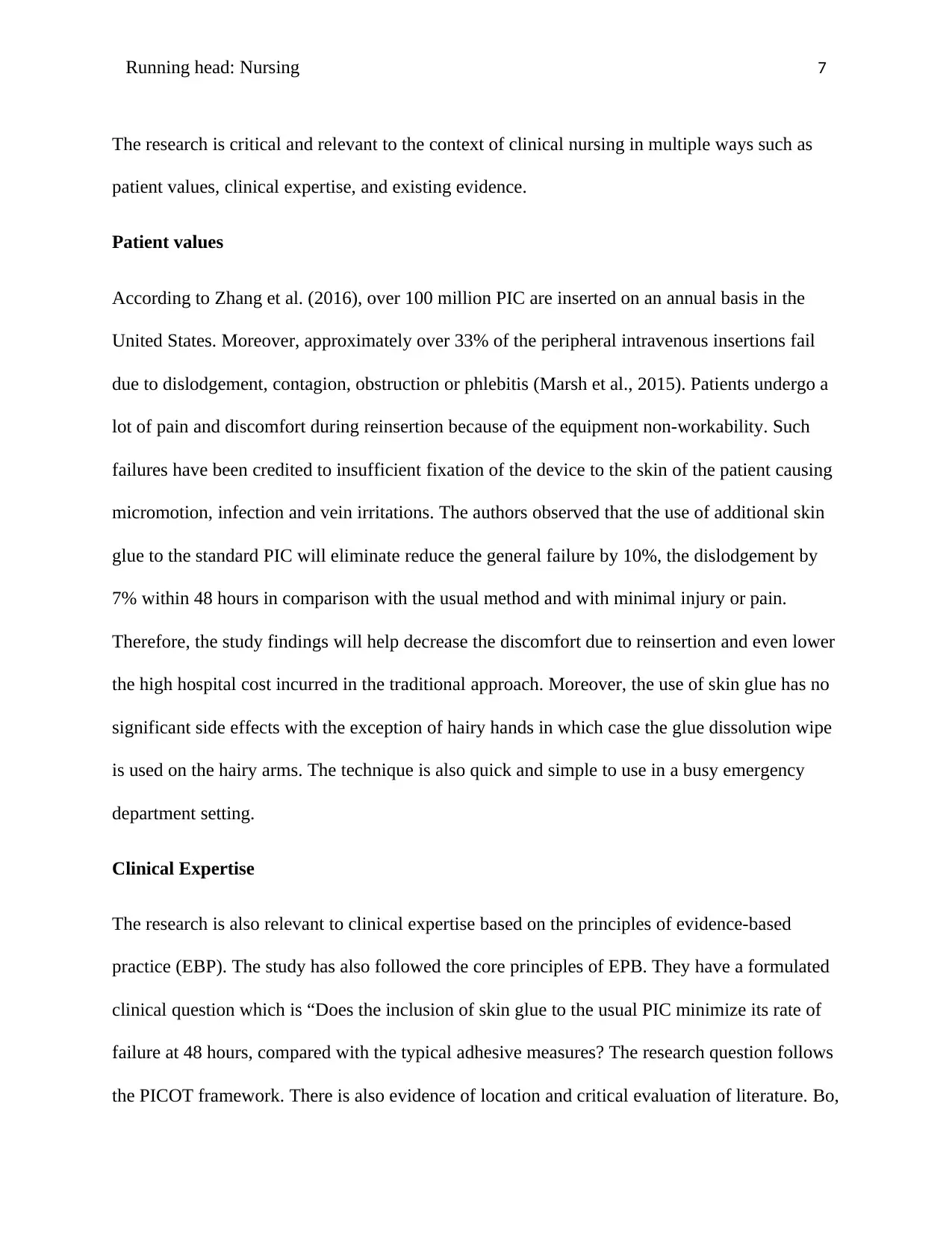
Running head: Nursing 7
The research is critical and relevant to the context of clinical nursing in multiple ways such as
patient values, clinical expertise, and existing evidence.
Patient values
According to Zhang et al. (2016), over 100 million PIC are inserted on an annual basis in the
United States. Moreover, approximately over 33% of the peripheral intravenous insertions fail
due to dislodgement, contagion, obstruction or phlebitis (Marsh et al., 2015). Patients undergo a
lot of pain and discomfort during reinsertion because of the equipment non-workability. Such
failures have been credited to insufficient fixation of the device to the skin of the patient causing
micromotion, infection and vein irritations. The authors observed that the use of additional skin
glue to the standard PIC will eliminate reduce the general failure by 10%, the dislodgement by
7% within 48 hours in comparison with the usual method and with minimal injury or pain.
Therefore, the study findings will help decrease the discomfort due to reinsertion and even lower
the high hospital cost incurred in the traditional approach. Moreover, the use of skin glue has no
significant side effects with the exception of hairy hands in which case the glue dissolution wipe
is used on the hairy arms. The technique is also quick and simple to use in a busy emergency
department setting.
Clinical Expertise
The research is also relevant to clinical expertise based on the principles of evidence-based
practice (EBP). The study has also followed the core principles of EPB. They have a formulated
clinical question which is “Does the inclusion of skin glue to the usual PIC minimize its rate of
failure at 48 hours, compared with the typical adhesive measures? The research question follows
the PICOT framework. There is also evidence of location and critical evaluation of literature. Bo,
The research is critical and relevant to the context of clinical nursing in multiple ways such as
patient values, clinical expertise, and existing evidence.
Patient values
According to Zhang et al. (2016), over 100 million PIC are inserted on an annual basis in the
United States. Moreover, approximately over 33% of the peripheral intravenous insertions fail
due to dislodgement, contagion, obstruction or phlebitis (Marsh et al., 2015). Patients undergo a
lot of pain and discomfort during reinsertion because of the equipment non-workability. Such
failures have been credited to insufficient fixation of the device to the skin of the patient causing
micromotion, infection and vein irritations. The authors observed that the use of additional skin
glue to the standard PIC will eliminate reduce the general failure by 10%, the dislodgement by
7% within 48 hours in comparison with the usual method and with minimal injury or pain.
Therefore, the study findings will help decrease the discomfort due to reinsertion and even lower
the high hospital cost incurred in the traditional approach. Moreover, the use of skin glue has no
significant side effects with the exception of hairy hands in which case the glue dissolution wipe
is used on the hairy arms. The technique is also quick and simple to use in a busy emergency
department setting.
Clinical Expertise
The research is also relevant to clinical expertise based on the principles of evidence-based
practice (EBP). The study has also followed the core principles of EPB. They have a formulated
clinical question which is “Does the inclusion of skin glue to the usual PIC minimize its rate of
failure at 48 hours, compared with the typical adhesive measures? The research question follows
the PICOT framework. There is also evidence of location and critical evaluation of literature. Bo,
Paraphrase This Document
Need a fresh take? Get an instant paraphrase of this document with our AI Paraphraser
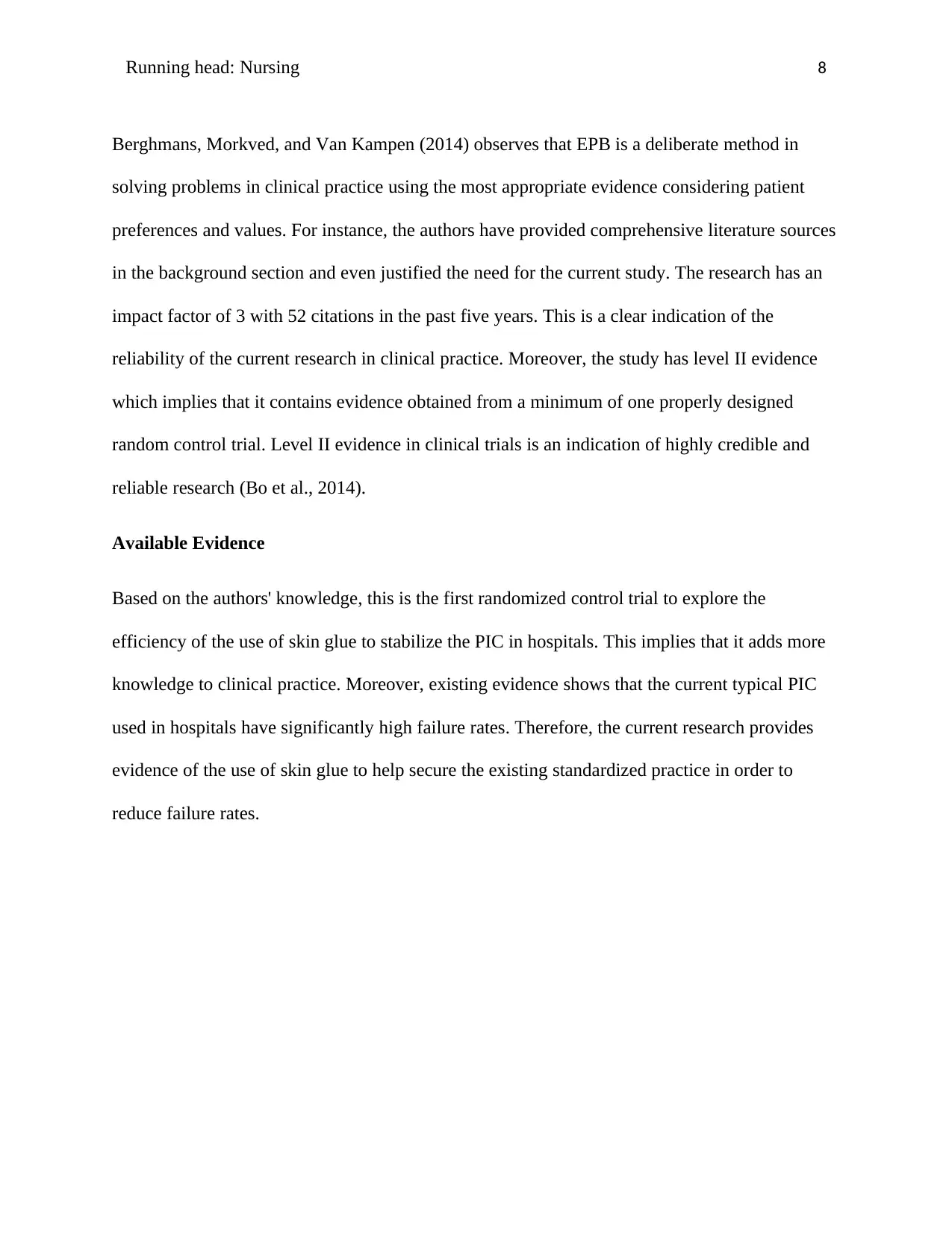
Running head: Nursing 8
Berghmans, Morkved, and Van Kampen (2014) observes that EPB is a deliberate method in
solving problems in clinical practice using the most appropriate evidence considering patient
preferences and values. For instance, the authors have provided comprehensive literature sources
in the background section and even justified the need for the current study. The research has an
impact factor of 3 with 52 citations in the past five years. This is a clear indication of the
reliability of the current research in clinical practice. Moreover, the study has level II evidence
which implies that it contains evidence obtained from a minimum of one properly designed
random control trial. Level II evidence in clinical trials is an indication of highly credible and
reliable research (Bo et al., 2014).
Available Evidence
Based on the authors' knowledge, this is the first randomized control trial to explore the
efficiency of the use of skin glue to stabilize the PIC in hospitals. This implies that it adds more
knowledge to clinical practice. Moreover, existing evidence shows that the current typical PIC
used in hospitals have significantly high failure rates. Therefore, the current research provides
evidence of the use of skin glue to help secure the existing standardized practice in order to
reduce failure rates.
Berghmans, Morkved, and Van Kampen (2014) observes that EPB is a deliberate method in
solving problems in clinical practice using the most appropriate evidence considering patient
preferences and values. For instance, the authors have provided comprehensive literature sources
in the background section and even justified the need for the current study. The research has an
impact factor of 3 with 52 citations in the past five years. This is a clear indication of the
reliability of the current research in clinical practice. Moreover, the study has level II evidence
which implies that it contains evidence obtained from a minimum of one properly designed
random control trial. Level II evidence in clinical trials is an indication of highly credible and
reliable research (Bo et al., 2014).
Available Evidence
Based on the authors' knowledge, this is the first randomized control trial to explore the
efficiency of the use of skin glue to stabilize the PIC in hospitals. This implies that it adds more
knowledge to clinical practice. Moreover, existing evidence shows that the current typical PIC
used in hospitals have significantly high failure rates. Therefore, the current research provides
evidence of the use of skin glue to help secure the existing standardized practice in order to
reduce failure rates.

Running head: Nursing 9
References
Bo, K., Berghmans, B., Morkved, S., & Van Kampen, M. (2014). Evidence-Based Physical
Therapy for the Pelvic Floor-E-Book: Bridging Science and Clinical Practice (2nd ed.).
Amsterdam, Netherlands: Elsevier Health Sciences.
Bugden, S., Shean, K., Scott, M., Mihala, G., Clark, S., Johnstone, C., ... & Rickard, C. M.
(2016). Skin glue reduces the failure rate of emergency department–inserted peripheral
intravenous catheters: A randomized controlled trial. Annals of emergency
medicine, 68(2), 196-201.
Clarke, B., Gillies, D., Illari, P., Russo, F., & Williamson, J. (2014). Mechanisms and the
evidence hierarchy. Topoi, 33(2), 339-360.
Creswell, J. W., & Creswell, J. D. (2017). Research design: Qualitative, quantitative, and mixed
methods approaches (4th ed.). California, CR, US: Sage publications.
Edwards, M., Rickard, C. M., Rapchuk, I., Corley, A., Marsh, N., Spooner, A. J., ... & Fraser, J.
F. (2014). A pilot trial of bordered polyurethane dressings, tissue adhesive and sutureless
devices compared with standard polyurethane dressings for securing short-term arterial
catheters. Critical Care and Resuscitation, 16(3), 175-182.
Gahlot, R., Nigam, C., Kumar, V., Yadav, G., & Anupurba, S. (2014). Catheter-related
bloodstream infections. International journal of critical illness and injury science, 4(2),
162-168.
References
Bo, K., Berghmans, B., Morkved, S., & Van Kampen, M. (2014). Evidence-Based Physical
Therapy for the Pelvic Floor-E-Book: Bridging Science and Clinical Practice (2nd ed.).
Amsterdam, Netherlands: Elsevier Health Sciences.
Bugden, S., Shean, K., Scott, M., Mihala, G., Clark, S., Johnstone, C., ... & Rickard, C. M.
(2016). Skin glue reduces the failure rate of emergency department–inserted peripheral
intravenous catheters: A randomized controlled trial. Annals of emergency
medicine, 68(2), 196-201.
Clarke, B., Gillies, D., Illari, P., Russo, F., & Williamson, J. (2014). Mechanisms and the
evidence hierarchy. Topoi, 33(2), 339-360.
Creswell, J. W., & Creswell, J. D. (2017). Research design: Qualitative, quantitative, and mixed
methods approaches (4th ed.). California, CR, US: Sage publications.
Edwards, M., Rickard, C. M., Rapchuk, I., Corley, A., Marsh, N., Spooner, A. J., ... & Fraser, J.
F. (2014). A pilot trial of bordered polyurethane dressings, tissue adhesive and sutureless
devices compared with standard polyurethane dressings for securing short-term arterial
catheters. Critical Care and Resuscitation, 16(3), 175-182.
Gahlot, R., Nigam, C., Kumar, V., Yadav, G., & Anupurba, S. (2014). Catheter-related
bloodstream infections. International journal of critical illness and injury science, 4(2),
162-168.
⊘ This is a preview!⊘
Do you want full access?
Subscribe today to unlock all pages.

Trusted by 1+ million students worldwide
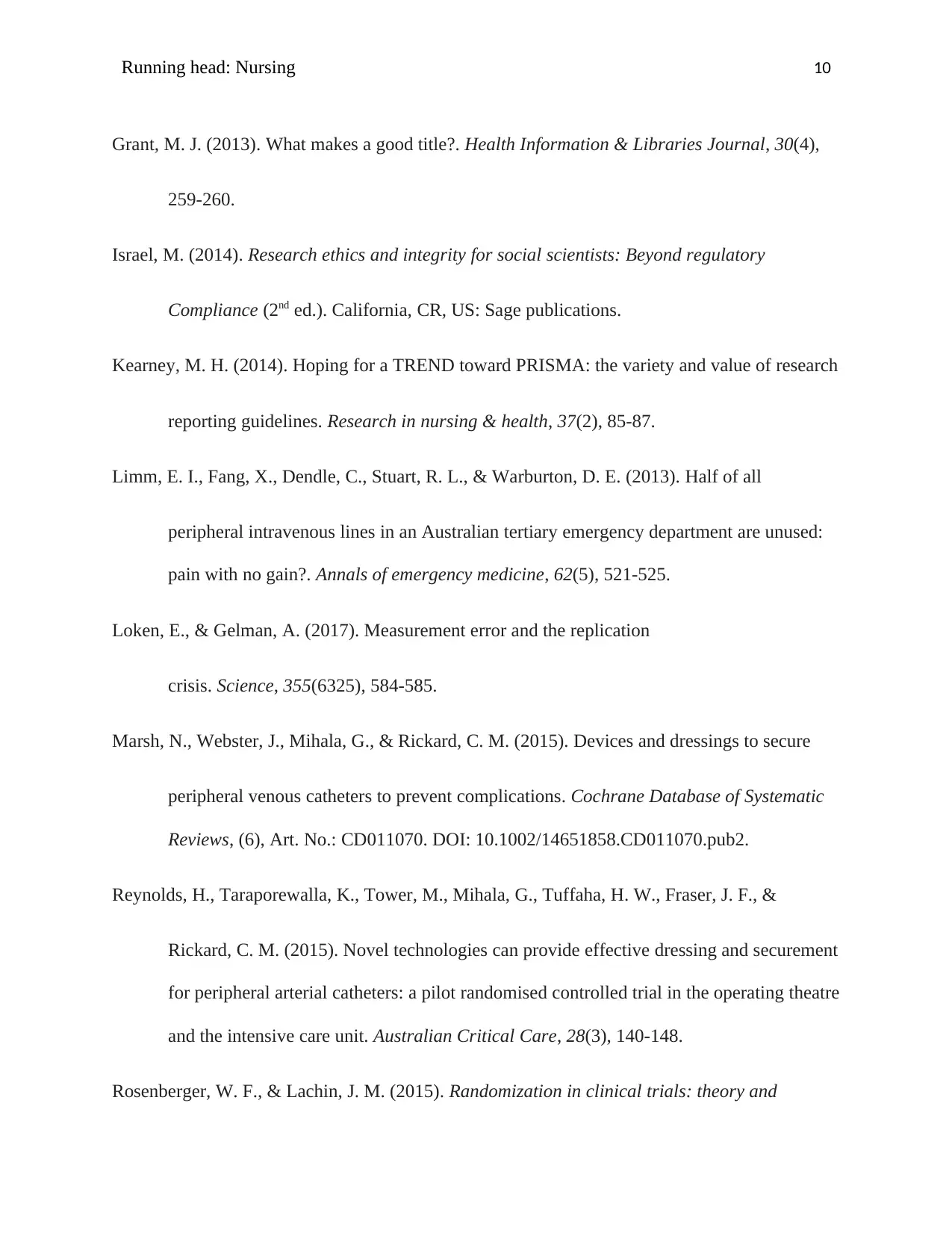
Running head: Nursing 10
Grant, M. J. (2013). What makes a good title?. Health Information & Libraries Journal, 30(4),
259-260.
Israel, M. (2014). Research ethics and integrity for social scientists: Beyond regulatory
Compliance (2nd ed.). California, CR, US: Sage publications.
Kearney, M. H. (2014). Hoping for a TREND toward PRISMA: the variety and value of research
reporting guidelines. Research in nursing & health, 37(2), 85-87.
Limm, E. I., Fang, X., Dendle, C., Stuart, R. L., & Warburton, D. E. (2013). Half of all
peripheral intravenous lines in an Australian tertiary emergency department are unused:
pain with no gain?. Annals of emergency medicine, 62(5), 521-525.
Loken, E., & Gelman, A. (2017). Measurement error and the replication
crisis. Science, 355(6325), 584-585.
Marsh, N., Webster, J., Mihala, G., & Rickard, C. M. (2015). Devices and dressings to secure
peripheral venous catheters to prevent complications. Cochrane Database of Systematic
Reviews, (6), Art. No.: CD011070. DOI: 10.1002/14651858.CD011070.pub2.
Reynolds, H., Taraporewalla, K., Tower, M., Mihala, G., Tuffaha, H. W., Fraser, J. F., &
Rickard, C. M. (2015). Novel technologies can provide effective dressing and securement
for peripheral arterial catheters: a pilot randomised controlled trial in the operating theatre
and the intensive care unit. Australian Critical Care, 28(3), 140-148.
Rosenberger, W. F., & Lachin, J. M. (2015). Randomization in clinical trials: theory and
Grant, M. J. (2013). What makes a good title?. Health Information & Libraries Journal, 30(4),
259-260.
Israel, M. (2014). Research ethics and integrity for social scientists: Beyond regulatory
Compliance (2nd ed.). California, CR, US: Sage publications.
Kearney, M. H. (2014). Hoping for a TREND toward PRISMA: the variety and value of research
reporting guidelines. Research in nursing & health, 37(2), 85-87.
Limm, E. I., Fang, X., Dendle, C., Stuart, R. L., & Warburton, D. E. (2013). Half of all
peripheral intravenous lines in an Australian tertiary emergency department are unused:
pain with no gain?. Annals of emergency medicine, 62(5), 521-525.
Loken, E., & Gelman, A. (2017). Measurement error and the replication
crisis. Science, 355(6325), 584-585.
Marsh, N., Webster, J., Mihala, G., & Rickard, C. M. (2015). Devices and dressings to secure
peripheral venous catheters to prevent complications. Cochrane Database of Systematic
Reviews, (6), Art. No.: CD011070. DOI: 10.1002/14651858.CD011070.pub2.
Reynolds, H., Taraporewalla, K., Tower, M., Mihala, G., Tuffaha, H. W., Fraser, J. F., &
Rickard, C. M. (2015). Novel technologies can provide effective dressing and securement
for peripheral arterial catheters: a pilot randomised controlled trial in the operating theatre
and the intensive care unit. Australian Critical Care, 28(3), 140-148.
Rosenberger, W. F., & Lachin, J. M. (2015). Randomization in clinical trials: theory and
Paraphrase This Document
Need a fresh take? Get an instant paraphrase of this document with our AI Paraphraser
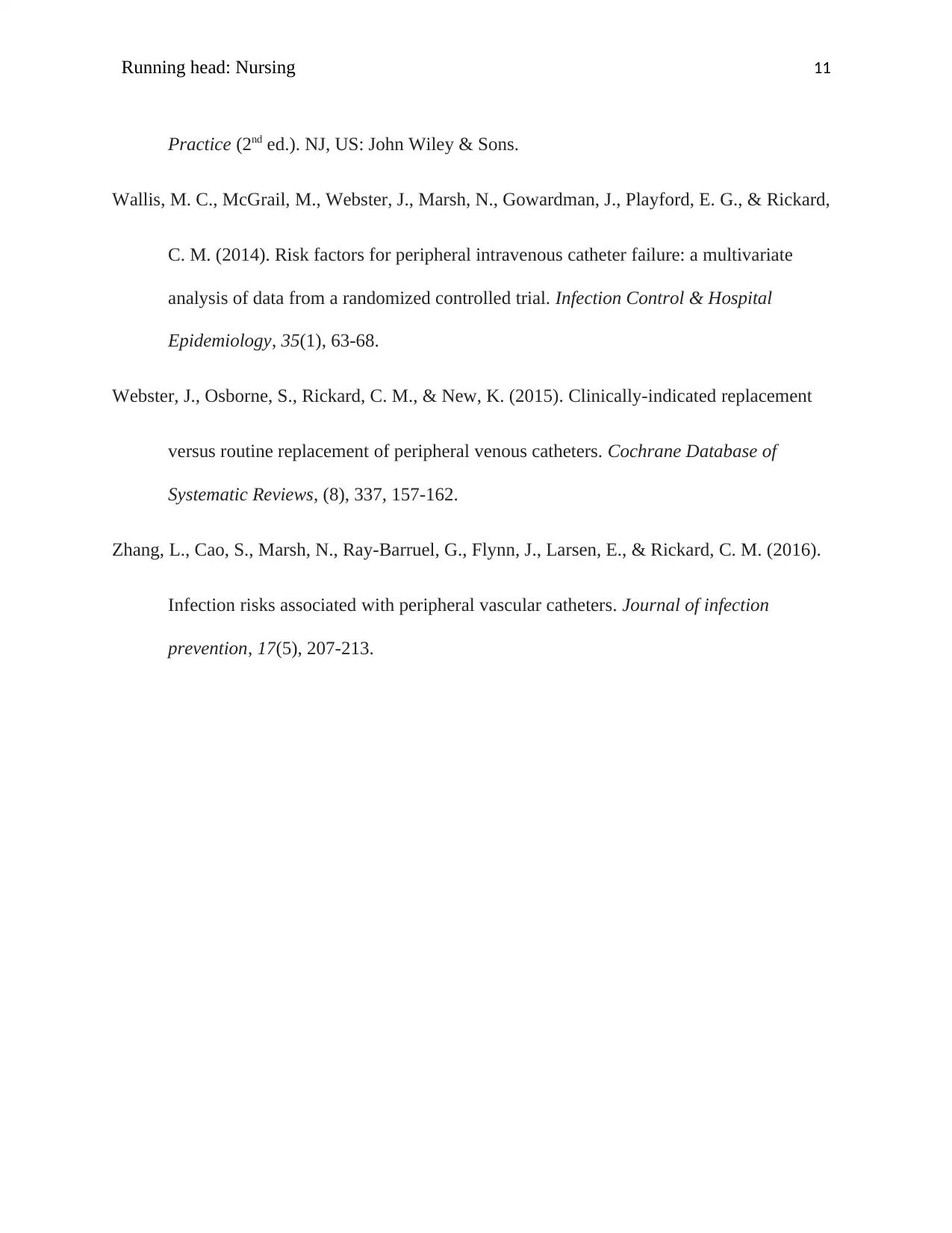
Running head: Nursing 11
Practice (2nd ed.). NJ, US: John Wiley & Sons.
Wallis, M. C., McGrail, M., Webster, J., Marsh, N., Gowardman, J., Playford, E. G., & Rickard,
C. M. (2014). Risk factors for peripheral intravenous catheter failure: a multivariate
analysis of data from a randomized controlled trial. Infection Control & Hospital
Epidemiology, 35(1), 63-68.
Webster, J., Osborne, S., Rickard, C. M., & New, K. (2015). Clinically‐indicated replacement
versus routine replacement of peripheral venous catheters. Cochrane Database of
Systematic Reviews, (8), 337, 157-162.
Zhang, L., Cao, S., Marsh, N., Ray-Barruel, G., Flynn, J., Larsen, E., & Rickard, C. M. (2016).
Infection risks associated with peripheral vascular catheters. Journal of infection
prevention, 17(5), 207-213.
Practice (2nd ed.). NJ, US: John Wiley & Sons.
Wallis, M. C., McGrail, M., Webster, J., Marsh, N., Gowardman, J., Playford, E. G., & Rickard,
C. M. (2014). Risk factors for peripheral intravenous catheter failure: a multivariate
analysis of data from a randomized controlled trial. Infection Control & Hospital
Epidemiology, 35(1), 63-68.
Webster, J., Osborne, S., Rickard, C. M., & New, K. (2015). Clinically‐indicated replacement
versus routine replacement of peripheral venous catheters. Cochrane Database of
Systematic Reviews, (8), 337, 157-162.
Zhang, L., Cao, S., Marsh, N., Ray-Barruel, G., Flynn, J., Larsen, E., & Rickard, C. M. (2016).
Infection risks associated with peripheral vascular catheters. Journal of infection
prevention, 17(5), 207-213.

Running head: Nursing 12
⊘ This is a preview!⊘
Do you want full access?
Subscribe today to unlock all pages.

Trusted by 1+ million students worldwide
1 out of 12
Related Documents
Your All-in-One AI-Powered Toolkit for Academic Success.
+13062052269
info@desklib.com
Available 24*7 on WhatsApp / Email
![[object Object]](/_next/static/media/star-bottom.7253800d.svg)
Unlock your academic potential
Copyright © 2020–2025 A2Z Services. All Rights Reserved. Developed and managed by ZUCOL.





